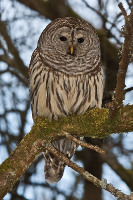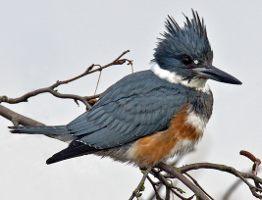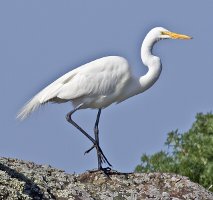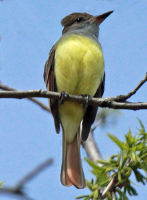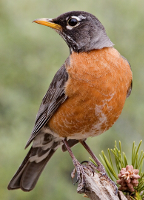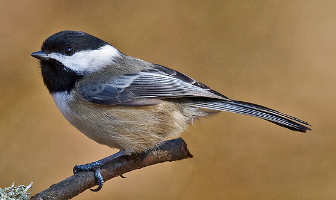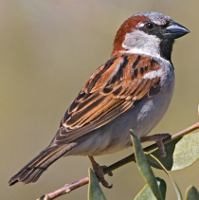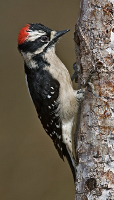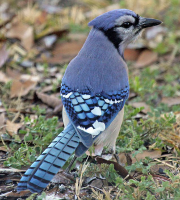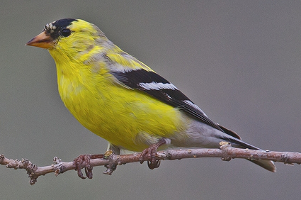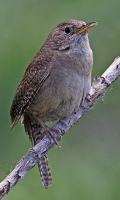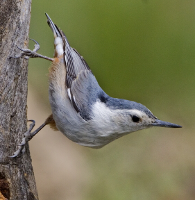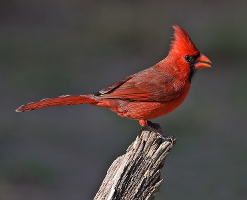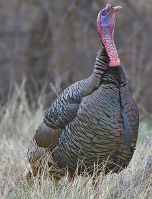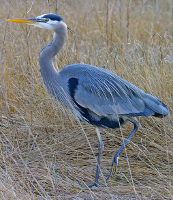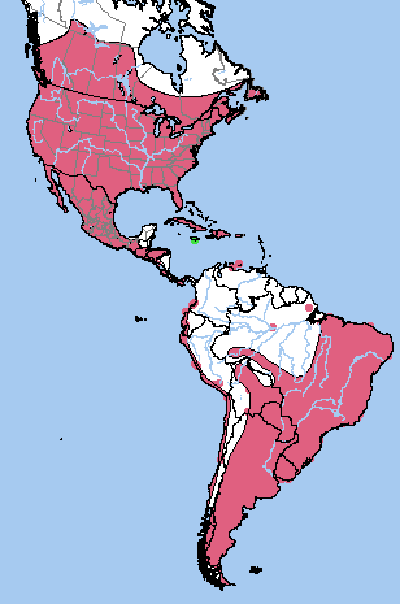Station 16
House Sparrow
 Physical Traits
Physical Traits
House Sparrows are chunkier than other sparrows, fuller in the chest, with a larger, rounded head, shorter tail, and stouter bill than most American sparrows. Male House Sparrows are brightly colored birds with gray heads, white cheeks, a black bib, and rufous neck – although in cities you may see some that are dull and grubby. Females are a plain buffy-brown overall with dingy gray-brown underparts. Their backs are noticeably striped with buff, black, and brown.
 Habitat
Habitat
House Sparrows eat mostly grains and seeds, as well as livestock feed and, in cities, discarded food. Among the crops they eat are corn, oats, wheat, and sorghum. Wild foods include ragweed, crabgrass and other grasses, and buckwheat. House Sparrows readily eat birdseed including millet, milo, and sunflower seeds. Urban birds readily eat commercial bird seed. In summer, House Sparrows eat insects and feed them to their young. They catch insects in the air, by pouncing on them, or by following lawnmowers or visiting lights at dusk.
 Diet
Diet
House Sparrows eat mostly grains and seeds, as well as livestock feed and, in cities, discarded food. Among the crops they eat are corn, oats, wheat, and sorghum. Wild foods include ragweed, crabgrass and other grasses, and buckwheat. House Sparrows readily eat birdseed including millet, milo, and sunflower seeds. Urban birds readily eat commercial bird seed. In summer, House Sparrows eat insects and feed them to their young. They catch insects in the air, by pouncing on them, or by following lawnmowers or visiting lights at dusk.
 Behavior
Behavior
House Sparrows hop rather than walk on the ground. They are social, feeding in crowded flocks and squabbling over crumbs or seeds on the ground. House Sparrows are a common sight at bird feeders; you may also see them bathing in street-side puddles or dustbathing on open ground, ruffling their feathers and flicking water or dust over themselves with similar motions. From living in such close company, House Sparrows have developed many ways of indicating dominance and submission. Nervous birds flick their tails. Aggravated birds crouch with the body horizontal, shove their head forward and partially spread and roll forward their wings, and hold the tail erect. This can intensify to a display with wings lifted, crown and throat feathers standing on end, tail fanned, and beak open. Males with larger amounts of black on the throat tend to dominate over males with less black. When males display to a prospective mate, they fluff up their chest, hold their wings partially open, fan the tail, and hop stiffly in front of the female, turning sideways and sometimes bowing up and down. Sometimes, other males who spot such a display in progress will fly in and begin displaying as well. In flocks, males tend to dominate over females in fall and winter, but females assert themselves in spring and summer.
 Nest Building Techniques
Nest Building Techniques
House Sparrow nests are made of coarse dried vegetation, often stuffed into the hole until it’s nearly filled. The birds then use finer material, including feathers, string, and paper, for the lining. House Sparrows sometimes build nests next to each other, and these neighboring nests can share walls. House Sparrows often reuse their nests. House Sparrows nest in holes of buildings and other structures such as streetlights, gas-station roofs, signs, and the overhanging fixtures that hold traffic lights. They sometimes build nests in vines climbing the walls of buildings. House Sparrows are strong competitors for nest boxes, too, at times displacing the species the nest box was intended for, such as bluebirds and Tree Swallows. House Sparrows nest in holes in trees somewhat less often.
 Cool Facts
Cool Facts
 The House Sparrow takes frequent dust baths. It throws soil and dust over its body feathers, just as if it were bathing with water. In doing so, a sparrow may make a small depression in the ground, and sometimes defends this spot against other sparrows.
The House Sparrow takes frequent dust baths. It throws soil and dust over its body feathers, just as if it were bathing with water. In doing so, a sparrow may make a small depression in the ground, and sometimes defends this spot against other sparrows. House Sparrows in flocks have a pecking order much the way chickens in a farmyard do. You can begin to decipher the standings by paying attention to the black throats of the males. Males with larger patches of black tend to be older and dominant over males with less black. By wearing this information on their feathers, sparrows can avoid some fights and thereby save energy
House Sparrows in flocks have a pecking order much the way chickens in a farmyard do. You can begin to decipher the standings by paying attention to the black throats of the males. Males with larger patches of black tend to be older and dominant over males with less black. By wearing this information on their feathers, sparrows can avoid some fights and thereby save energy
 Where is the Sparrow?
Where is the Sparrow?
Look to your left,this one is very close,
about 4 meters ahead is a small Ironwood tree,
the Ironwood tree is also known as the Hop Hornbeam tree,
about 2 meters up in a fork is the House Sparrow replica.
Want a picture of where to look ??
Want to see the replica ??


